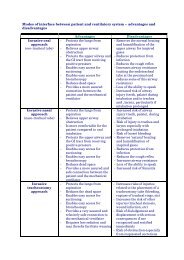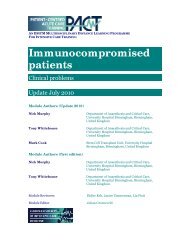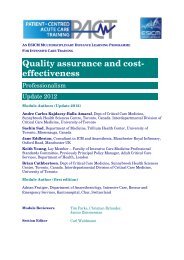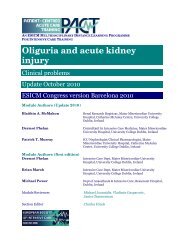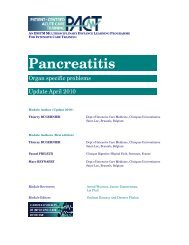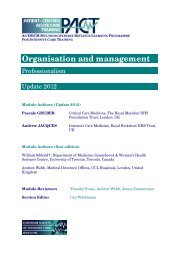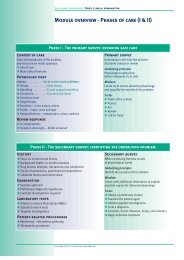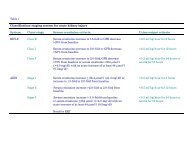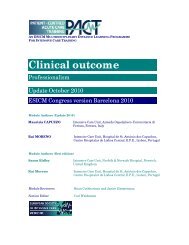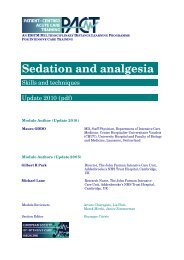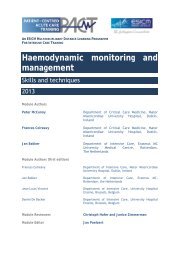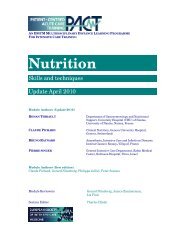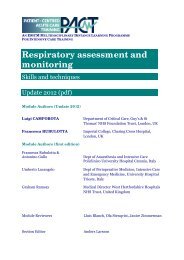Burns injury - PACT - ESICM
Burns injury - PACT - ESICM
Burns injury - PACT - ESICM
Create successful ePaper yourself
Turn your PDF publications into a flip-book with our unique Google optimized e-Paper software.
Invasive infections<br />
Infection is a major cause of morbidity and mortality in burn patients. Due to the<br />
broken skin barrier, central i.v. catheters and invasive ventilator therapy, patients<br />
with burn <strong>injury</strong> are susceptible to infections as early as 24–72 hrs after the incident.<br />
Wound and pulmonary infections are the most common. Early extubation is important<br />
to avoid ventilator associated pneumonia (VAP). Patients with inhalation <strong>injury</strong> are<br />
particularly susceptible to lung infections, and some of them develop the Acute<br />
Respiratory Distress Syndrome (X-rays in interactive version). Initially, Gram-positive<br />
bacteria (skin organisms) predominate, and the most common microbes are<br />
Staphylococcus epidermidis and aureus. With increasing length of hospital stay,<br />
Gram-negative organisms such as Pseudomonas sp. [image in interactive version] are<br />
common pathogens. Another major problem is the more resistant Gram-positive<br />
organisms such as MRSA and VRE. Fungal infections also appear later, especially if<br />
broad spectrum antibacterials have been used for a long time.<br />
The common signs of infection such as pyrexia, leukocytosis, and other elevated<br />
markers of inflammation are frequently seen in burn <strong>injury</strong> patients in the absence of<br />
invasive infections. This makes diagnosis tricky. It is important for the clinician to<br />
monitor the patient over time to tailor antibiotic treatment. In addition to the<br />
classical signs of invasive infection, evaluate the general clinical condition of the<br />
patient [higher fever (> 39 C), tachycardia, hypovolaemia, increasing CRP, PCT,<br />
blood sugar and increased gastric residual volume] as indirect signs that might point<br />
to an invasive infection. Always do a septic work-up incorporating new swabs,<br />
protected (brush) sampling (if indicated and the patient is intubated), urine and<br />
blood cultures before antibiotics are introduced or changed.<br />
Sepsis is the major cause of death in patients who survive the initial burn<br />
<strong>injury</strong>. Remember that central catheters, arterial lines, gall bladder, sinuses,<br />
endocarditis and decubitus ulcers might be the source of an intercurrent infection.<br />
Antibiotics<br />
Prophylactic antibiotics should not be given. Aim for short courses of narrowspectrum<br />
antibiotics targeted to clinical, invasive infection and modify/refine<br />
therapy based on microbiological results.<br />
Perioperative antibiotic use during wound debridement and grafting remains<br />
controversial, but is commonly administered for 24 hrs perioperatively in patients<br />
with large burns. The antibiotics used should be dependent on the microbes<br />
identified in that particular patient or those usually present in the unit. A common<br />
combination is an aminoglycoside and penicillinase resistant penicillin.<br />
The pharmacokinetics are different in burn patients requiring larger doses and more<br />
frequent dosing of antibiotics. A longer therapeutic course may be indicated if the<br />
burn wounds are purulent; the agent of choice being guided by recent (septic workup<br />
or surveillance) culture results. As the volume of distribution is unpredictable and<br />
generally significantly increased, antibiotic concentrations should be monitored;<br />
subtherapeutic concentrations may contribute to the selection of resistant microorganisms.<br />
For more information see the <strong>PACT</strong> modules on Severe Infection and Sepsis and<br />
MODS.<br />
28



